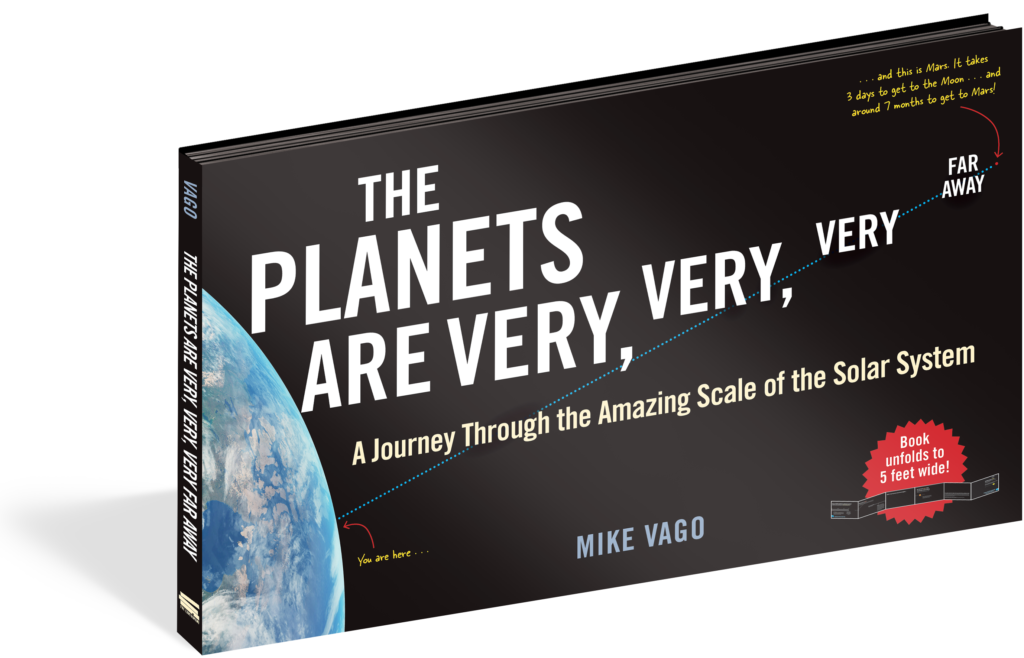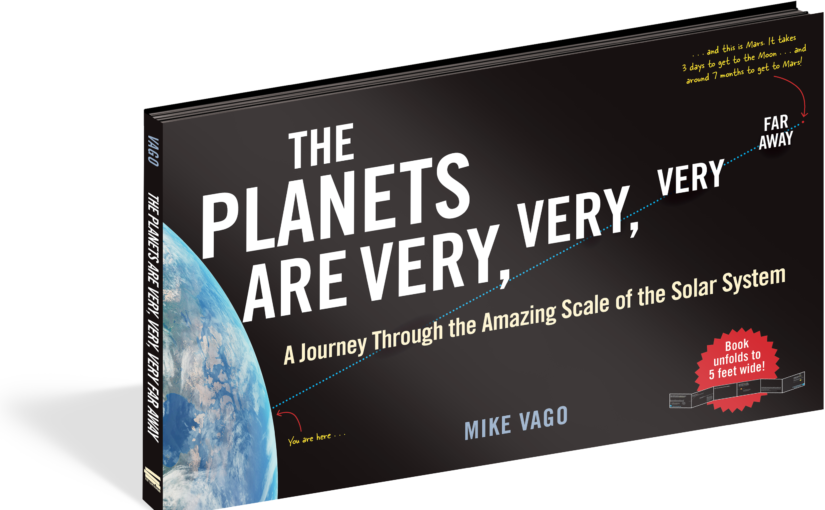I was talking to a student one day about the approximate distance between Georgia and New York and they had absolutely no clue. Their spatial abilities were suspect at best with them guessing at only a couple of hundred miles to multiple thousands. Space is like that too, except so much more interesting and potentially complex. The Planets Are Very, Very, Very Far Away puts the impossibly massive scale of the solar system into a scope that anyone is able to understand. Author Mike Vago is an author who produces books that are as much of a publishing statement as they are informative, entertaining, or both.

His previous book that we reviewed was Rocket, a hands-on thick, paged book for young audiences. It had a 3-D rocket that young hands would maneuver through the pages as it slid in its tracks that were grooved into the pages. That is a fascinating, durable, tank of a book that held up through one child and was in good enough condition to where we were able to donate it to our local book barn so that another child could enjoy it.

The Planets Are Very, Very, Very Far Away takes that same curious DNA and feeds it with STEM, specifically the enormity of the solar system. It does this by immediately showing upper elementary and middle school readers the model of the solar system that they’re used to seeing. It’s the ball model where everything is lined up on a circular tract. Vago then introduces scale with some common things that those ages will recognize, but are vastly different in the real-world. After comparing a desk and an elephant, the Sun, at a scale of 10,000,000,000-to-1 is brought in.

Vago does a great job at making the science of the solar system approachable and fun. He accomplishes this by acknowledging that it’s all very weird, writing in a conversational tone and comparing it to absurd things or pointing out the obvious. Planets do not orbit in a circle, rather they do so in an oval shape and, because the planets are always moving they’ll be closer to them at different times.
The MacGuffin in The Planets Are Very, Very, Very Far Away is in the book’s fold-out pages. The first one that readers will encounter covers the first three planets in the solar system and their relationship to the sun. You’ll see a yellow dot, about the size of a dime with instructions on the left page that tell you to open the page so that you can go to Mercury. When you do so you’ll see a black page that simulates the vastness of the solar system. The top of each page has a graph that’s spaced out every centimeter, with each one representing a million kilometers. Each page is just over 24 centimeters long, which is a lot of space.

Even as we see Venus it’s not the correct representation of its size, relative to the Sun or Earth. Venus, as well as Earth, is 10 times larger than they need to be in the book, but that’s required in order for readers to see them. Old-school map readers will appreciate the prompt at the bottom of the far right page that asks you to fold everything back in the book.
As you continue turning the pages you’ll read snippets about Mercury, Venus, Earth, and Mars, as well as, some facts (or previously taught lies) about space. The next series of pages that fold out have to reset the scale of the solar system. Here, the yellow dot is about one-fourth of the diameter of a pencil eraser, the respectively listed three planets are shown, but smaller than they were initially, and we see Mars. The massive, unfathomable scale of the space between things is now starting the sink in. By the time the book gets to Uranus and Neptune the scale of the sun is just a speck of dust, with lots of black. You’ll also see the location of the planet’s moons (not to scale), an explanation of the dwarf planets. The book ends with a short look at our solar system and shows how it scales into the Milky Way galaxy.
The landscape layout of The Planets Are Very, Very, Very Far Away perfectly suits the horizontal scale that the book accomplishes. As we learned in the book, I know that all planets don’t go in a parallel line, but it’s needed in this case. The book treats readers of any age with respect and asks as many questions as it answers. Moreover, it gets readers to imagine and ask even more questions, many of which you might not be able to answer, but that’s OK. It’s also the point of science, which is to ask questions, seek out the answers and then ask more questions.
The Planets Are Very, Very, Very Far Away: A Journey Through the Amazing Scale of the Solar System is by Mike Vago and is available on The Experiment.
There are affiliate links in this post.






 Facebook
Facebook Twitter
Twitter Flickr
Flickr GooglePlus
GooglePlus Youtube
Youtube